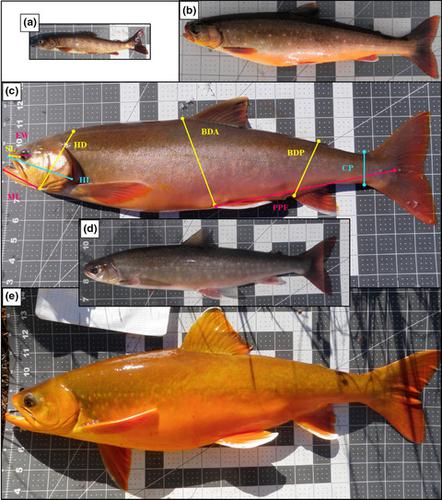当前位置:
X-MOL 学术
›
Ecol. Evol.
›
论文详情
Our official English website, www.x-mol.net, welcomes your feedback! (Note: you will need to create a separate account there.)
Investigating the morphological and genetic divergence of arctic char (Salvelinus alpinus) populations in lakes of arctic Alaska
Ecology and Evolution ( IF 2.6 ) Pub Date : 2021-03-05 , DOI: 10.1002/ece3.7211 Stephen L. Klobucar 1 , Jessica A. Rick 2, 3 , Elizabeth G. Mandeville 2, 4 , Catherine E. Wagner 2, 3 , Phaedra Budy 1, 5
Ecology and Evolution ( IF 2.6 ) Pub Date : 2021-03-05 , DOI: 10.1002/ece3.7211 Stephen L. Klobucar 1 , Jessica A. Rick 2, 3 , Elizabeth G. Mandeville 2, 4 , Catherine E. Wagner 2, 3 , Phaedra Budy 1, 5
Affiliation

|
Polymorphism facilitates coexistence of divergent morphs (e.g., phenotypes) of the same species by minimizing intraspecific competition, especially when resources are limiting. Arctic char (Salvelinus sp.) are a Holarctic fish often forming morphologically, and sometimes genetically, divergent morphs. In this study, we assessed the morphological and genetic diversity and divergence of 263 individuals from seven populations of arctic char with varying length‐frequency distributions across two distinct groups of lakes in northern Alaska. Despite close geographic proximity, each lake group occurs on landscapes with different glacial ages and surface water connectivity, and thus was likely colonized by fishes at different times. Across lakes, a continuum of physical (e.g., lake area, maximum depth) and biological characteristics (e.g., primary productivity, fish density) exists, likely contributing to characteristics of present‐day char populations. Although some lakes exhibit bimodal size distributions, using model‐based clustering of morphometric traits corrected for allometry, we did not detect morphological differences within and across char populations. Genomic analyses using 15,934 SNPs obtained from genotyping by sequencing demonstrated differences among lake groups related to historical biogeography, but within lake groups and within individual lakes, genetic differentiation was not related to total body length. We used PERMANOVA to identify environmental and biological factors related to observed char size structure. Significant predictors included water transparency (i.e., a primary productivity proxy), char density (fish·ha‐1), and lake group. Larger char occurred in lakes with greater primary production and lower char densities, suggesting less intraspecific competition and resource limitation. Thus, char populations in more productive and connected lakes may prove more stable to environmental changes, relative to food‐limited and closed lakes, if lake productivity increases concomitantly. Our findings provide some of the first descriptions of genomic characteristics of char populations in arctic Alaska, and offer important consideration for the persistence of these populations for subsistence and conservation.
中文翻译:

调查北极阿拉斯加湖中北极char(Salvelinus alpinus)种群的形态和遗传差异
多态性通过最小化种内竞争,促进同一个物种的不同形态(例如,表型)的共存,特别是在资源有限的情况下。北极红点鲑(Salvelinus(sp。)是一种Holocctic鱼,通常在形态上(有时在遗传上)形成不同的形态。在这项研究中,我们评估了阿拉斯加北部两个不同湖泊群的7个北极炭化种群中263个个体的形态,遗传多样性和发散性,它们的长短频率分布各不相同。尽管地理位置接近,但每个湖泊群都出现在具有不同冰川年龄和地表水连通性的景观上,因此很可能在不同的时间被鱼类定居。在整个湖泊中,存在着连续的物理(例如,湖泊面积,最大深度)和生物学特征(例如,初级生产力,鱼类密度),这可能有助于当今的char鱼种群特征。尽管有些湖泊表现出双峰大小分布,我们使用基于模型的聚类的形态特征进行了聚类,该形态特征针对异种异体症进行了校正,因此我们没有检测到char种群内部和种群之间的形态差异。使用从测序中获得基因型的15934个SNP进行的基因组分析表明,与历史生物地理学相关的湖泊群之间存在差异,但在湖泊群内和单个湖泊内,遗传分化与总体长无关。我们使用PERMANOVA来确定与观察到的焦炭尺寸结构有关的环境和生物学因素。重要的预测指标包括水的透明度(即主要的生产力指标),炭的密度(鱼·公顷)通过测序从基因分型中获得的934个SNPs证明了与历史生物地理学相关的湖泊群之间的差异,但是在湖泊群内和单个湖泊内,遗传分化与总体长度无关。我们使用PERMANOVA来确定与观察到的焦炭尺寸结构有关的环境和生物学因素。重要的预测指标包括水的透明度(即主要的生产力指标),炭的密度(鱼·公顷)通过测序从基因分型中获得的934个SNPs证明了与历史生物地理学相关的湖泊群之间的差异,但是在湖泊群内和单个湖泊内,遗传分化与总体长度无关。我们使用PERMANOVA来确定与观察到的焦炭尺寸结构有关的环境和生物学因素。重要的预测指标包括水的透明度(即主要的生产力指标),炭的密度(鱼·公顷)‐1)和湖泊群。较大的焦炭发生在湖泊中,其初级生产力较高,且焦炭密度较低,表明种内竞争和资源限制较少。因此,如果湖泊生产力随之提高,则相对于食物有限和封闭的湖泊,生产力更高且相互连接的湖泊中的炭黑种群可能证明对环境变化更稳定。我们的发现为北极阿拉斯加的炭黑种群的基因组特征提供了一些最初的描述,并为这些种群的持续生存和保护提供了重要的考虑。
更新日期:2021-04-04
中文翻译:

调查北极阿拉斯加湖中北极char(Salvelinus alpinus)种群的形态和遗传差异
多态性通过最小化种内竞争,促进同一个物种的不同形态(例如,表型)的共存,特别是在资源有限的情况下。北极红点鲑(Salvelinus(sp。)是一种Holocctic鱼,通常在形态上(有时在遗传上)形成不同的形态。在这项研究中,我们评估了阿拉斯加北部两个不同湖泊群的7个北极炭化种群中263个个体的形态,遗传多样性和发散性,它们的长短频率分布各不相同。尽管地理位置接近,但每个湖泊群都出现在具有不同冰川年龄和地表水连通性的景观上,因此很可能在不同的时间被鱼类定居。在整个湖泊中,存在着连续的物理(例如,湖泊面积,最大深度)和生物学特征(例如,初级生产力,鱼类密度),这可能有助于当今的char鱼种群特征。尽管有些湖泊表现出双峰大小分布,我们使用基于模型的聚类的形态特征进行了聚类,该形态特征针对异种异体症进行了校正,因此我们没有检测到char种群内部和种群之间的形态差异。使用从测序中获得基因型的15934个SNP进行的基因组分析表明,与历史生物地理学相关的湖泊群之间存在差异,但在湖泊群内和单个湖泊内,遗传分化与总体长无关。我们使用PERMANOVA来确定与观察到的焦炭尺寸结构有关的环境和生物学因素。重要的预测指标包括水的透明度(即主要的生产力指标),炭的密度(鱼·公顷)通过测序从基因分型中获得的934个SNPs证明了与历史生物地理学相关的湖泊群之间的差异,但是在湖泊群内和单个湖泊内,遗传分化与总体长度无关。我们使用PERMANOVA来确定与观察到的焦炭尺寸结构有关的环境和生物学因素。重要的预测指标包括水的透明度(即主要的生产力指标),炭的密度(鱼·公顷)通过测序从基因分型中获得的934个SNPs证明了与历史生物地理学相关的湖泊群之间的差异,但是在湖泊群内和单个湖泊内,遗传分化与总体长度无关。我们使用PERMANOVA来确定与观察到的焦炭尺寸结构有关的环境和生物学因素。重要的预测指标包括水的透明度(即主要的生产力指标),炭的密度(鱼·公顷)‐1)和湖泊群。较大的焦炭发生在湖泊中,其初级生产力较高,且焦炭密度较低,表明种内竞争和资源限制较少。因此,如果湖泊生产力随之提高,则相对于食物有限和封闭的湖泊,生产力更高且相互连接的湖泊中的炭黑种群可能证明对环境变化更稳定。我们的发现为北极阿拉斯加的炭黑种群的基因组特征提供了一些最初的描述,并为这些种群的持续生存和保护提供了重要的考虑。



























 京公网安备 11010802027423号
京公网安备 11010802027423号